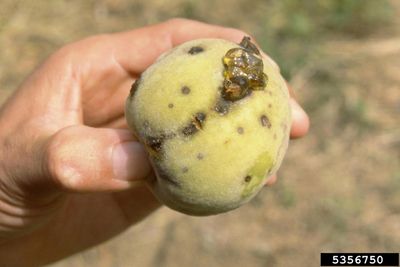What Causes Peach Shot Hole Disease?
Peach shot hole, sometimes also called coryneum blight, is caused by a fungus called Wilsonomyces carpophilus. The most common symptoms of peach shot hole fungus are lesions on the twigs, buds, and leaves. These lesions start out as small, dark purple spots. Over time, these spots spread and turn brown, usually with a purple border. Eventually, dark bumps will form in the center of each lesion – these release spores that further spread the disease. Infected buds turn dark brown to black and shiny with gum. On infected leaves, the center of these lesions will often fall out, creating the “shot hole” appearance that earns the disease its name. In wet weather, the fungus will sometimes spread to the fruits, where it develops dark brown and purple spots on the skin and hard, corky areas in the flesh underneath.
Treating Peach Shot Hole
Peach shot hole fungus overwinters in old lesions and spreads its spores in damp weather, especially with splashing water. The most common method of treating peach shot hole is the spraying of fungicide in the autumn just after leaf drop, or in the spring just before budbreak. If peach shot hole has been known to be a problem in past seasons, it’s a good idea to prune out and destroy infected wood. Try to keep trees dry, and never irrigate in a way that wets the leaves. For organic treatments, zinc sulfate and copper sprays have been shown to be effective.
